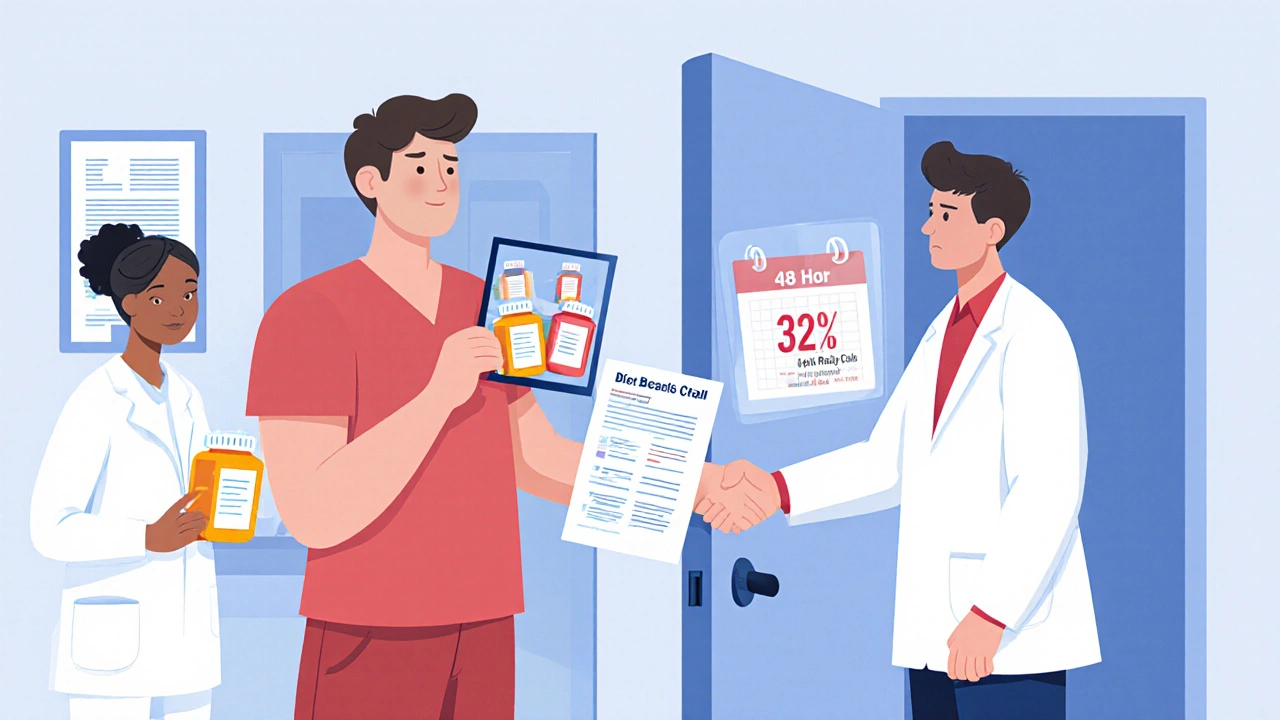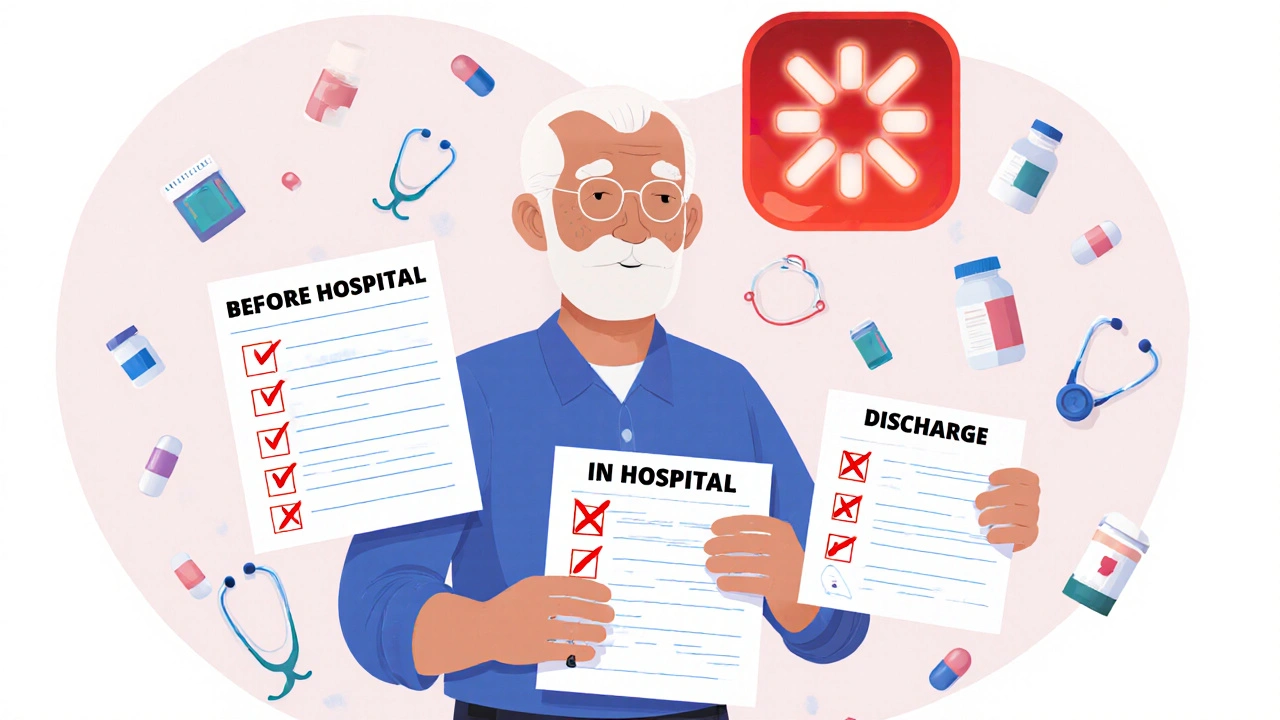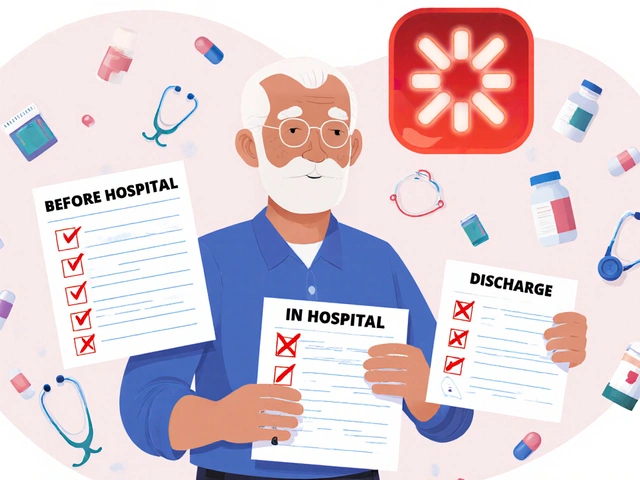When you leave the hospital, your body is still healing. But the biggest risk to your recovery isn’t always the illness you were treated for-it’s the medication plan you take home. Studies show that up to 70% of patients leave the hospital with a medication list that doesn’t match what they were actually taking before admission. These mismatches lead to dangerous errors: missed doses, wrong strengths, or drugs that clash dangerously with each other. One in five patients ends up back in the hospital within 30 days because of a medication mistake after discharge. This isn’t bad luck. It’s a system failure-and it’s fixable.
Why Medication Reconciliation Isn’t Optional
Medication reconciliation isn’t just paperwork. It’s a safety checkpoint. The National Quality Forum calls it NQF 0097, and the Centers for Medicare & Medicaid Services (CMS) requires it. Why? Because during a hospital stay, your meds change constantly. An anticoagulant gets paused. A blood pressure pill gets doubled. A painkiller you’ve taken for years gets dropped because it’s not needed in the hospital. But when you go home, no one checks if those changes were meant to be permanent.Take a real example: A 72-year-old man with atrial fibrillation had his blood thinner stopped during his hospital stay for pneumonia. He didn’t know it was only temporary. When he got home, he never restarted it. Three weeks later, he had a stroke. The hospital discharge summary said the medication was discontinued. The primary care doctor didn’t know it was a hospital-only pause. No one asked the patient what he was taking before admission. That’s a reconciliation failure.
Reconciliation means comparing three lists: what you were taking before hospitalization, what you were given in the hospital, and what you’re leaving with. If those don’t match, someone missed something. And that gap is where harm happens.
The Three Ways Reconciliation Happens (And Which One Works Best)
There are two main ways reconciliation is done after discharge-and one of them is far more effective.Option 1: The Phone Call or Virtual Visit (CPT II Code 1111F)
This is when your primary care provider calls you within 30 days of discharge. They ask: “What meds are you taking now?” They compare it to your discharge list. They check if you filled the prescriptions. They look for duplicates, omissions, or dangerous combinations. No office visit needed. No billing reimbursement. Just a call.This method is flexible. It can be done by a nurse, pharmacist, or even a trained medical assistant. But here’s the problem: if no one is paid for it, it often gets pushed to the bottom of the to-do list. Many clinics don’t do it at all.
Option 2: The Transitions of Care Visit (CPT 99495/99496)
This is an in-person visit billed to insurance. It’s more thorough. You come in, your meds are reviewed, and the provider documents everything. The catch? Only one of these visits can be billed per hospital discharge. And here’s the big conflict: if you saw a specialist before being hospitalized (like a cardiologist), and now you’re seeing your primary doctor, who gets to bill for the reconciliation? Often, neither does. The paperwork gets tangled. The patient gets caught in the middle.Option 3: The Pharmacist-Led Approach (The Winner)
The best results come from pharmacists-not doctors or nurses-leading the reconciliation. A 2023 study in the Journal of the American College of Clinical Pharmacy found that when pharmacists handled post-discharge med reviews, medication errors dropped by 32.7%. Readmissions fell by 28.3%. Why? Pharmacists are trained to spot drug interactions, dosing errors, and adherence issues. They know what a “medication history” really looks like: not just what’s written on a piece of paper, but what the patient actually takes.Pharmacists don’t just ask, “Are you taking your pills?” They ask: “Do you still have the bottle from last week?” “Did the pharmacy give you the same strength as before?” “Did your daughter help you fill the prescriptions?” They check pill bottles, pharmacy records, and even text messages from caregivers. They find the gaps that doctors miss.
What Your Medication List Should Include (And What Most People Forget)
A full medication list isn’t just pills. It’s everything you put in or on your body. Here’s what you need to track:- Prescription drugs (even ones you only take occasionally)
- Over-the-counter meds (ibuprofen, antacids, sleep aids)
- Vitamins and supplements (fish oil, vitamin D, magnesium)
- Herbs and botanicals (turmeric, ginkgo, garlic pills)
- Topical creams and ointments (steroid creams, pain patches)
- Eye drops, ear drops, inhalers
- Insulin and injectables (even if you’re not on them daily)
Many patients forget the creams. One man had a skin rash treated with a steroid cream in the hospital. He didn’t think it counted as a “medication.” He stopped using it. His rash came back worse. His doctor blamed him for “non-compliance.” The truth? No one asked him about it.
Before you leave the hospital, write down every single thing you take. Include the dose, how often, and why. If you don’t know why, write “don’t know.” Better to say “don’t know” than to guess.

How to Prepare for Your Post-Discharge Check-In
Don’t wait for someone to call you. Take control. Here’s what to do:- Get a copy of your discharge summary-not just the instructions. Ask for the full medication list they used to send you home with.
- Bring all your meds to your follow-up appointment-in the original bottles. Don’t rely on your memory or a pill organizer.
- Ask: “What changed?” Don’t just say “thanks.” Ask specifically: “What meds were added? What was stopped? What was changed in dose?”
- Ask: “Why?” If a drug was stopped, ask if it’s permanent. If it’s a new drug, ask what it’s for and what side effects to watch for.
- Ask: “Who do I call if I’m confused?” Get a name, number, and best time to call. Don’t just get a generic clinic line.
Some patients think the hospital’s job ends when they walk out. It doesn’t. Your job starts now. You are the most important person in your own care coordination.
What Happens When Nothing Is Done
If no reconciliation happens, here’s what you risk:- Getting a new drug that interacts with something you’re already taking (like mixing blood thinners with ibuprofen)
- Stopping a drug you need (like beta-blockers for heart failure)
- Being given the wrong dose (a 5mg pill instead of 10mg, or vice versa)
- Not filling a prescription because you didn’t know it was important
- Double-dosing because two doctors prescribed the same thing without knowing
These aren’t rare. The Agency for Healthcare Research and Quality says 30-70% of hospital transitions have medication discrepancies. And 18-50% of all post-discharge medication errors happen because no one checked.
And the cost? Medication errors after discharge contribute to 6.5% of all hospital readmissions. That’s $21.4 billion a year in the U.S. alone. It’s not just your health on the line-it’s the whole system’s efficiency.

What’s Changing in 2025
The rules are tightening. CMS now includes medication reconciliation in its Merit-based Incentive Payment System (MIPS). If your doctor’s clinic doesn’t meet the 78% national average for reconciliation, their payments could drop by up to 9% in 2025. That’s pushing clinics to finally take it seriously.More hospitals are now embedding pharmacists into discharge teams. In 2023, only 48% of hospitals had pharmacists involved in discharge med reviews. By 2026, that’s expected to jump to 75%. AI tools are also emerging-some can scan your EHR and flag potential mismatches before you even leave the hospital.
And patients? More are using apps to track meds in real time. Apps like Medisafe or MyTherapy let you log what you take, set reminders, and even share updates with your doctor. Top-performing clinics now use these tools as part of their reconciliation process.
What You Can Do Right Now
You don’t need to wait for the system to fix itself. Here’s your action plan:- Before leaving the hospital, ask for a printed copy of your discharge meds.
- Take photos of every pill bottle you have at home.
- Call your primary care doctor within 48 hours of discharge and say: “I just got out of the hospital. I need my meds reviewed.”
- If they don’t have a process, ask if they can refer you to a pharmacist for a medication therapy management session.
- If you’re still confused after 3 days, call your hospital’s discharge nurse. They’re still responsible for your handoff.
Medication reconciliation isn’t a one-time event. It’s an ongoing conversation. The hospital’s job ends when you leave. Your job begins the moment you walk out the door. Don’t assume someone else is watching your meds. You are the only one who can make sure nothing falls through the cracks.
What if I don’t have a primary care doctor after discharge?
If you don’t have a primary care doctor, contact your hospital’s discharge planning team. They’re required to help you find one. Many hospitals have partnerships with community clinics or pharmacists who offer free post-discharge med reviews. You can also call your local health department or search for a Federally Qualified Health Center (FQHC) near you. These clinics serve patients regardless of insurance and often provide medication reconciliation as part of their standard care.
Can I do medication reconciliation myself?
You can and should start the process yourself-but you can’t replace a professional review. Gather your meds, write down what you take, and compare it to your discharge list. But only a trained pharmacist or provider can spot hidden interactions, correct dosing errors, or know if a drug was stopped intentionally. Your role is to provide accurate information. Their role is to interpret it safely.
Why do I need to bring all my pill bottles to the appointment?
Because labels can be wrong. Pills can be mislabeled. You might have taken a generic version that looks different. Your pharmacy might have switched brands. A bottle says “5 mg,” but the pill inside is half that size. Only by seeing the actual bottles can your provider confirm what you’re really taking. Don’t rely on memory or a list written months ago.
What if my discharge meds conflict with what my specialist prescribed?
That’s exactly why reconciliation matters. If your cardiologist prescribed a new blood thinner and your primary doctor didn’t know about it, you could end up on two blood thinners at once. Bring both lists to your appointment. Ask: “Do these work together?” If there’s a conflict, your provider should contact the specialist to resolve it. Never assume two doctors are talking to each other.
How do I know if my reconciliation was done properly?
Ask for a written summary of the reconciliation. It should list your pre-hospital meds, your discharge meds, and what changed. It should say why each change was made. If you get a one-page checklist with no explanations, it wasn’t done right. Proper reconciliation includes documentation of patient understanding-your provider should ask you to repeat back your new plan in your own words.
If you’re still unsure after your follow-up, ask for a referral to a medication therapy management (MTM) pharmacist. These specialists are trained to untangle complex med regimens. They’re often covered by Medicare Part D and many private plans. Don’t wait for a crisis. Your meds are too important to leave to chance.



mike tallent
November 17, 2025 AT 19:08Just got out of the hospital last week and this hit home hard. I brought all my bottles to my follow-up and the nurse almost cried when she saw I was still taking that old blood thinner they'd stopped inpatient. No one told me it was temporary. I thought they just forgot to write it down. Thanks for the wake-up call 🙏
Joyce Genon
November 19, 2025 AT 03:02Let’s be real - this whole ‘medication reconciliation’ thing is just another bureaucratic money grab disguised as patient care. Doctors don’t care. Pharmacists are overworked. Patients are expected to be medical detectives while the system collapses. And now we’re supposed to believe AI will fix it? Please. The real problem is that hospitals discharge people like they’re returning a rental car - no inspection, no cleanup, just ‘have a nice day.’
John Wayne
November 20, 2025 AT 11:26The emphasis on pharmacists is misplaced. They’re not clinicians. They’re dispensers. The real solution is to give primary care physicians more time - not to outsource responsibility to pharmacy technicians who don’t understand the clinical context. This is a systems problem, not a role reallocation problem.
Julie Roe
November 21, 2025 AT 21:47I work in home health and I’ve seen this play out too many times. Elderly patients with 12 meds, no family nearby, and a discharge sheet that says ‘continue all meds’ - but half of them were stopped in the hospital. One woman took her husband’s blood pressure pill because she didn’t know the difference. She ended up in the ER with a heart rate of 38. It’s not negligence - it’s neglect wrapped in paperwork. The pharmacist-led model works because they actually talk to people. They ask, ‘Did you eat today?’ before they ask, ‘Are you taking lisinopril?’ That’s the difference. And if your clinic doesn’t offer MTM? Push. Hard. You’re worth it.
jalyssa chea
November 22, 2025 AT 13:30why do they make this so complicated i just want to know what pills to take and when why cant they just give me a simple list like a recipe why do i have to bring all my bottles and take photos and call someone and what if i dont have a phone or dont trust doctors or my daughter is in jail and cant help me and why is everyone so judgmental like its my fault i forgot my cream
Gary Lam
November 22, 2025 AT 21:58Man, I love how Americans treat meds like a Netflix subscription - ‘I’ll just pause it when I’m in the hospital and resume when I get back.’ Meanwhile, in India, my cousin’s grandma takes 17 pills a day and no one’s ever seen a discharge summary. She just asks the pharmacy guy, ‘Same as last time?’ And somehow, she’s fine. Maybe we overthink this. Or maybe we just need less bureaucracy and more trust in people.
Peter Stephen .O
November 23, 2025 AT 05:12Bro this is the most important thing I’ve read this year. I used to think meds were just ‘take one blue, one white, one green.’ Then my dad had a stroke because they stopped his anticoagulant and didn’t tell him. Now I keep a spreadsheet. I screenshot every bottle. I text my mom the names of new pills. I even made a sticky note that says ‘IF YOU FORGET, ASK WHY.’ You don’t need a PhD to survive this system - you just need to be annoying. Be the squeaky wheel. Be the one who brings the whole medicine cabinet. Because nobody else will. And yeah, I’m that guy now. And I’m proud of it 💪
Andrew Cairney
November 24, 2025 AT 11:52Let me guess - this is all part of the Big Pharma-Insurance-Medical Industrial Complex. They want you confused so you keep buying pills. Did you know that 70% of ‘medication errors’ are actually caused by pharmacists mislabeling bottles? And who funds the studies saying pharmacists are the answer? Pharma. Coincidence? I think not. Also, the AI tools they’re pushing? They’re trained on biased data. Your black neighbor gets a different discharge list than you. This isn’t safety. It’s surveillance with a stethoscope.
Rob Goldstein
November 25, 2025 AT 06:55As a clinical pharmacist who’s done over 500 post-discharge med reviews, I can confirm: the pharmacist-led model is the gold standard. We catch 3-5 errors per patient on average - things like duplicate anticoagulants, incorrect insulin dosing, or OTC NSAIDs interacting with heart meds. But here’s the kicker: most patients don’t know MTM is covered by Medicare Part D. It’s free. You just have to ask. If your PCP doesn’t offer it, call your pharmacy. Say: ‘I need a Medication Therapy Management session under my Part D benefits.’ They’ll schedule it. No referral needed. This isn’t magic - it’s access.
vinod mali
November 26, 2025 AT 21:21in india we dont have this system but we have family. my aunty takes all pills for 8 old people. she knows who takes what. no app no list no hospital. just memory and love. maybe we dont need more tech. maybe we need more people who care.
Jennie Zhu
November 27, 2025 AT 08:24While the clinical utility of pharmacist-led reconciliation is empirically supported, the operationalization of CPT codes 99495/99496 remains fraught with administrative inefficiencies, particularly in multi-specialty care transitions. The absence of interoperable EHR protocols for discharge summary reconciliation undermines the efficacy of even the most well-intentioned interventions. Furthermore, the reliance on patient self-reporting for medication histories introduces significant recall bias, which may compromise the validity of the reconciliation process. A standardized, algorithm-driven, longitudinal medication reconciliation framework, integrated with real-time pharmacy claims data, would represent a more robust, evidence-based solution.